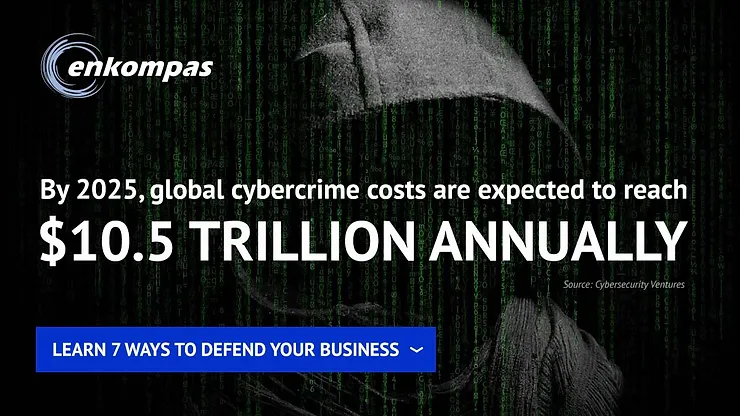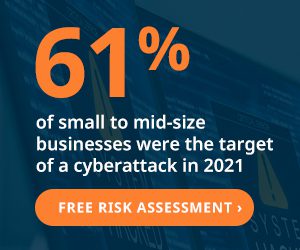While Health and Human Service organizations and workers have certainly benefitted from the advancement of technology, it has also introduced an unprecedented number of cybersecurity risks. For example, ransomware attacks hit businesses every 11 seconds in 2021, and ransoms can vary from hundreds of thousands to millions of dollars.
Why do companies end up paying cybercriminals these vast amounts? Because the cost of the downtime caused by cybercrime is typically higher than the ransom companies can end up paying!
In short, becoming a victim of cybercrime will cause your agency to take a huge financial hit. Therefore, if you want your organization to grow and succeed, you must fully understand and address the evolving world of cyberthreats.
The Reality of the Current Cyberthreat Landscape
Almost every organization will encounter cybercrime at some point. It’s not a question of IF, but rather WHEN it will happen. While that reality can be alarming, there’s no need to panic. There are proactive steps you can take to protect your business and achieve peace of mind. But first, let’s discuss what you need to be aware of.
Here are some of the most serious and prevalent cyberthreats facing organizations right now:
- Ransomware. Ransomware is malicious software that threatens to reveal sensitive data or prevent access to your files/systems until you pay a ransom payment within a set timeframe. Failure to pay on time can result in data leaks or irreversible data loss.
- Phishing/Business Email Compromise (BEC). Phishing is a cybercrime that involves a hacker impersonating a legitimate person or organization mostly through emails or through other methods such as SMS. Malicious actors employ phishing to send links or attachments that can be used to extract login credentials or install malware. Similarly, business email compromise (BEC) is a scam in which cybercriminals use compromised email accounts to trick victims into sending money or revealing sensitive information.
- Insider Threats. An insider threat arises from within a company. It could happen because of a current or former employee, vendor, or other business partner who has access to important corporate data and computer systems. Insider threats are hard to detect because they emerge from within and are not always intentional.
- Denial-of-Service / Distributed Denial-of-Service (DoS and DDoS). These attacks are widespread and easy to carry out. When a DoS or DDoS attack occurs, hackers flood the targeted system with repeated data requests, forcing it to slow down, crash or shut down.
If we still haven’t convinced you about your level of concern about these sophisticated threats, the following statistics ought to drive the point home.
- It takes an average of 280 days to identify and contain a breach.
- Malicious attacks with financial motivations were responsible for 52% of breaches.
- Personal Identifiable Information (PII) is compromised in 80% of data breaches.
Request a Quote for Our Services
Implement These Measures to Secure Your Organization from Cyberthreats
Now that you know what types of cyberthreats to look out for, let’s take a look at some measures that enkompas IT can help put in place to protect your business against cybercrimes. enkompas IT has a complete Cyber Security Stack to help safeguard your environment. The elements of our approach to cybersecurity include the following:
- Strict Password Policies / Management Tools: Strict password policies and the use of proper password management solutions can help improve your organization’s overall password hygiene. It’s the first line of protection against cybercriminals.
- Anti-virus and Anti-Malware Management: Antivirus software, also known as anti-malware, is a computer program used to prevent, detect, and remove malware.
- Strong Identity Controls – Multifactor Authentication (MFA): To combat the current threat landscape, strong identity controls that go beyond traditional username-password authentication are required. Consider using Multifactor authentication, which includes features such as one-time passwords (OTPs) and security questions.
- Security Information and Event Management (SEIM): Security information and event management is a field within the field of computer security, where software products and services combine security information management and security event management. They provide real-time analysis of security alerts generated by applications and network hardware.
- Virtual Private Network (VPN): To avoid a security breach, you should set up a corporate VPN that encrypts all your connections. Make sure your employees test it in their respective locations to avoid any hassles.
- Business Continuity Strategy: When disaster hits, a solid business continuity strategy ensures that mission-critical operations continue uninterrupted and that IT systems, software and applications remain accessible and recoverable.
- Continual Security Awareness Training: Continuous security training empowers your employees to recognize complex cyberthreats and take appropriate action, resulting in a transformative security culture within your organization.
If you’re ready to strengthen your cybersecurity posture but aren’t sure where to start, don’t worry. enkompas has helped many Health and Human Service organizations and can help you build a digital fortress of protection solutions. Contact us today to schedule a free consultation.

Sources:
- Cybersecurity Ventures (https://cybersecurityventures.com/cybercrime-damages-6-trillion-by-2021/)
- IBM Cost of Data Breach Report (https://www.ibm.com/downloads/cas/QMXVZX6R)


